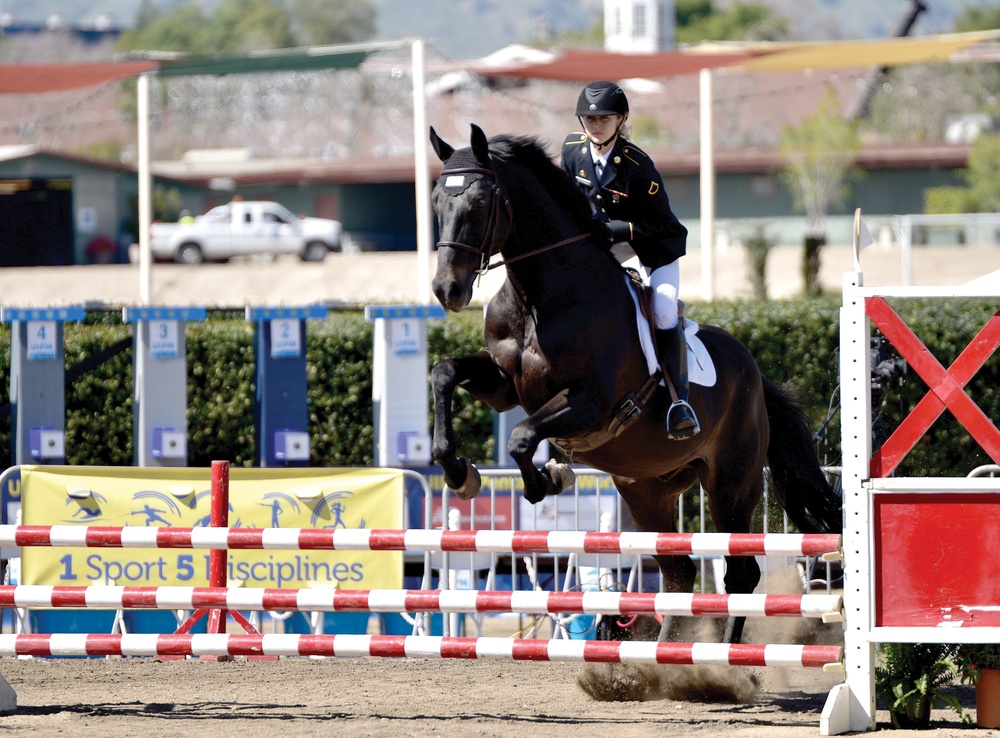When reciting the U.S. Army Soldier’s Creed, soldiers affirm that they are proficient in their “warrior tasks and drills.” This includes the basics of shooting, moving and communicating, among other critical skills that all soldiers must possess. Throughout the course of military history, some soldier skills have evolved while others have remained constant. The Ancient Olympic pentathlon and the modern Olympic pentathlon were modeled after these skills.

Pentathlon is Greek for “competition of five [events].” The Ancient Olympic pentathlon consisted of the stadion (foot race), javelin throw, discus throw, long jump, and (Ancient Greek) wrestling. Pentathlete training was often part of military service and all five events took place over the course of a single day. The pentathlon was first competed at the 18th Ancient Olympiad around 708 BC. Although the format of the contest changed over the years, it was generally standardized by the 77th Ancient Olympiad: long jump, javelin throw, and discus throw, followed by the stadion, with wrestling as the final event.
Scholars have been unable to determine how the winner of the Ancient pentathlon was selected. However, pentathletes were considered to be inferior to athletes who specialized in individual events. Still, the philosopher Aristotle held pentathletes in high regard. “Beauty varies with each age. In a young man, it consists in possessing a body capable of enduring all efforts, either of the racecourse or of bodily strength, while he himself is pleasant to look upon and a sheer delight,” Aristotle wrote in the Rhetoric. “This is why the athletes in the pentathlon are most beautiful, because they are naturally adapted for bodily exertion and for swiftness of foot.”

As warfare evolved, so too did the pentathlon. In 1912, the modern pentathlon was first held at the Games of the V Olympiad in Stockholm. The president of the International Olympic Committee, Pierre de Coubertin, took inspiration from the Ancient pentathlon and based the events on the skills that a 19th century cavalry soldier would need to escape back to friendly lines from behind enemy lines: ride an unfamiliar horse, fight enemies with a pistol and sword, swim, and run to evade capture. As such, the modern pentathlon consists of riding, pistol shooting, fencing, swimming, and running.
The original distance of the swimming event was 300m. This was reduced to 200m at the 2000 Sydney Olympics. Fencing was originally competed in a round-robin format. In 2015, an additional bonus round was added to épée fencing in international competitions. This was reflected at the 2016 Rio Olympics.

The riding event was originally cross-country with a distance of 5km. In 1972, the event was reduced to 4km. At the 1988 Olympics in Seoul, the riding event was changed to show jumping. Shooting was originally done with regular pistols, but was later switched to sport pistols. After the 1988 Olympics, shooting was changed to .177-caliber air pistol from the standing position at 10m with a stationary target. For the 2011 World Cup, the air pistols were equipped with laser transmitters and continue to be used.
The running event was 4km until the 2000 Sydney Olympics; it was shortened to a 3km cross-country run. In 2009, running and shooting were combined. Competitors ran three 1000m laps, each preceded by laser pistol shooting at five targets with a time limit of 70 seconds. Beginning with the 2013 season, the run was changed to four 800m laps and the shooting was changed to five targets in 50 seconds. After the 2020 Tokyo Olympics, the run was further modified to five 600m laps.

The modern pentathlon originally took place over the course of 4-6 days. Beginning with the 1996 Atlanta Olympics, all five events took place on the same day. To improve the audience experience, the 2024 Paris Olympics further consolidated the modern pentathlon into 90 minutes at the same venue (except for the fencing ranking round). The order of events is: fencing, ranking round; riding; swimming; fencing, bonus round; laser-run.
Beginning with the 2028 Los Angeles Olympics, the riding event will be replaced with obstacle course racing. The International Modern Pentathlon Union conducted a study which found that younger viewers are more likely to watch the Olympics on TV if it included an obstacle course race in the style of American Ninja Warrior. Modern pentathlon has also faced controversy over the riding of unfamiliar horses. Multiple female athletes at the 2020 Tokyo Olympics complained that they were unable to control their horses. Also at the Tokyo Games, German coach Kim Rainer was kicked out of the event for punching a horse in frustration. Overall, an obstacle course race that tests agility and strength better reflects modern soldiering than riding an unfamiliar horse.


